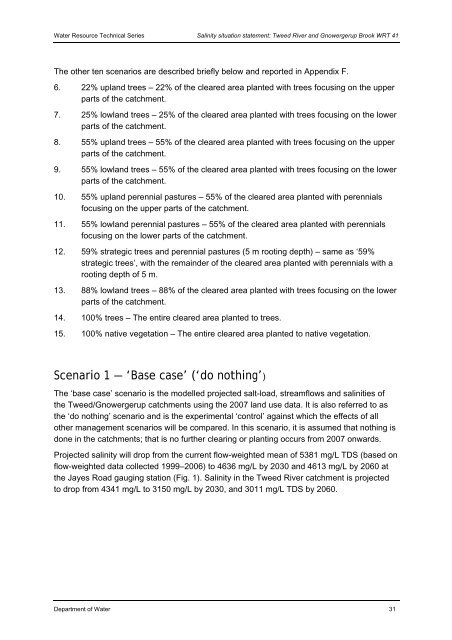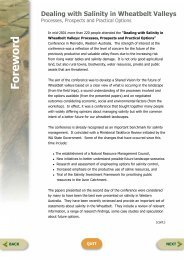Salinity situation statement Tweed River and Gnowergerup Brook
Salinity situation statement Tweed River and Gnowergerup Brook
Salinity situation statement Tweed River and Gnowergerup Brook
Create successful ePaper yourself
Turn your PDF publications into a flip-book with our unique Google optimized e-Paper software.
Water Resource Technical Series <strong>Salinity</strong> <strong>situation</strong> <strong>statement</strong>: <strong>Tweed</strong> <strong>River</strong> <strong>and</strong> <strong>Gnowergerup</strong> <strong>Brook</strong> WRT 41<br />
The other ten scenarios are described briefly below <strong>and</strong> reported in Appendix F.<br />
6. 22% upl<strong>and</strong> trees – 22% of the cleared area planted with trees focusing on the upper<br />
parts of the catchment.<br />
7. 25% lowl<strong>and</strong> trees – 25% of the cleared area planted with trees focusing on the lower<br />
parts of the catchment.<br />
8. 55% upl<strong>and</strong> trees – 55% of the cleared area planted with trees focusing on the upper<br />
parts of the catchment.<br />
9. 55% lowl<strong>and</strong> trees – 55% of the cleared area planted with trees focusing on the lower<br />
parts of the catchment.<br />
10. 55% upl<strong>and</strong> perennial pastures – 55% of the cleared area planted with perennials<br />
focusing on the upper parts of the catchment.<br />
11. 55% lowl<strong>and</strong> perennial pastures – 55% of the cleared area planted with perennials<br />
focusing on the lower parts of the catchment.<br />
12. 59% strategic trees <strong>and</strong> perennial pastures (5 m rooting depth) – same as ‘59%<br />
strategic trees’, with the remainder of the cleared area planted with perennials with a<br />
rooting depth of 5 m.<br />
13. 88% lowl<strong>and</strong> trees – 88% of the cleared area planted with trees focusing on the lower<br />
parts of the catchment.<br />
14. 100% trees – The entire cleared area planted to trees.<br />
15. 100% native vegetation – The entire cleared area planted to native vegetation.<br />
Scenario 1 — ‘Base case’ (‘do nothing’)<br />
The ‘base case’ scenario is the modelled projected salt-load, streamflows <strong>and</strong> salinities of<br />
the <strong>Tweed</strong>/<strong>Gnowergerup</strong> catchments using the 2007 l<strong>and</strong> use data. It is also referred to as<br />
the ‘do nothing’ scenario <strong>and</strong> is the experimental ‘control’ against which the effects of all<br />
other management scenarios will be compared. In this scenario, it is assumed that nothing is<br />
done in the catchments; that is no further clearing or planting occurs from 2007 onwards.<br />
Projected salinity will drop from the current flow-weighted mean of 5381 mg/L TDS (based on<br />
flow-weighted data collected 1999–2006) to 4636 mg/L by 2030 <strong>and</strong> 4613 mg/L by 2060 at<br />
the Jayes Road gauging station (Fig. 1). <strong>Salinity</strong> in the <strong>Tweed</strong> <strong>River</strong> catchment is projected<br />
to drop from 4341 mg/L to 3150 mg/L by 2030, <strong>and</strong> 3011 mg/L TDS by 2060.<br />
Department of Water 31













